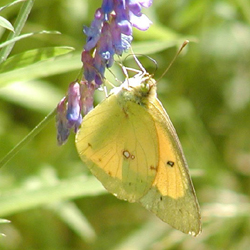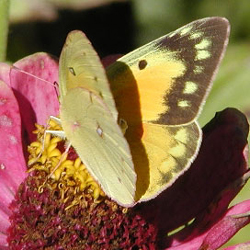Butterfly Atlas
Find a Butterfly
Orange Sulphur
Colias eurytheme
Named
Boisduval , 1852

Taxonomy & Nomenclature
Also known as the Alfalfa Butterfly.
Identification
Wingspan: 1 5/8 2 3/8". Orange yellow to rich orange on all upperwing surfaces (compare with lemon yellow upperwings in Clouded Sulphur). Black borders of upperwings solid in male; punctuated with yellow spots on forewing of female. Albinistic females (form "alba") are inseparable in the field from the "alba" form of the Clouded Sulphur.
Distribution
British Columbia east to Newfoundland and south throughout the continent to southern Mexico. Resident throughout New England. Formerly resident only west of the Appalachians, but with felling of the eastern forests in the nineteenth century and the subsequent planting/spread of vast acreages of suitable larval food plants, the species spread rapidly east and northeast from the late 1800‘s on.
Status in Massachusetts
Virtually unknown in New England in Scudder‘s time, with five regional and two Massachusetts records, all of single specimens. It began to become common in the state in the 1930‘s. On Martha‘s Vineyard "the observed change to its present status of an abundant resident species dates from 1930." (Kimball and Jones, 1943). Today, it is ubiquitous statewide. Maximum: 350+, 20-21 August 1994, Katama, Martha‘s Vineyard (Dukes Co.).

Flight Period in Massachusetts
Three overlapping broods, with individuals typically on the wing from mid May to early October. Extreme dates: 16 April 1991, Foxboro (Norfolk Co.), B. Cassie; and 26 December 1994, Martha‘s Vineyard (Dukes Co.), W. Keith.
Larval Food Plants
Various herbaceous legumes (Scott, 1986 lists eighteen genera), both native and introduced. Favorite hosts are Alfalfa (Medicago sativa), White Clover (Trifolium repens), White Sweet Clover (Melilotus alba), and vetches (Vicia, sp.).
Adult Food sources
Found on 38 species during the Atlas period. Virtually all available flowers utilized, from Common Winter Cress in May to late flowering asters in fall. Seventy at the Naval Air Station in South Weymouth on 3 August 1988 were all nectaring at Queen Anne‘s Lace and goldenrods.

Habitat
Open meadows and pastures at all elevations.
Life Cycle
EGG: Whitish, turning crimson; spindle shaped. OVIPOSITION: Eggs laid singly on upper surface of host plant leaf. LARVA: Dark green, with lateral whitish stripes. CHRYSALIS: Green, with yellow and black markings. OVERWINTERING STAGE: Chrysalis.
In May, when the days warm sufficiently, the first of the species begin to emerge from the pupa. Populations of the Orange Sulphur are normally low during spring and early summer and build to maximum size in late summer. During mate seeking flights, males patrol low over suitable open habitat. Actually, males of both Orange and Clouded Sulphurs may pursue the female Orange Sulphur, which uses visual and chemical clues to sort out potential partners. Male Orange Sulphurs reflect ultraviolet from the upper wing surfaces, while male Clouded Sulphurs absorb it. Since butterflies can see UV, males of the two species are readily distinguishable by the butterflies, and most female Orange Sulphurs ignore male Clouded Sulphurs on the basis of their UV wing pattern (Silberglied and Taylor, 1973, 1978). In addition, the two species possess different pheromones and that of the Orange Sulphur male uniquely signals the female to lower her abdomen for mating. Hybridization occurs when Clouded Sulphur populations reach very high densities and female Orange Sulphurs are overwhelmed by numbers of male Clouded Sulphurs or when female Orange Sulphurs have just emerged from the chrysalis and their ability to discern the differences between the two species is insufficiently developed (Scott, 1986). Larvae feed mainly at night. They are an economic pest in parts of the species‘ range.
Account Author
Brian Cassie



